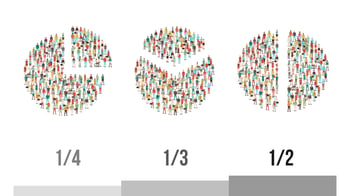
4 min read
As an HR professional, you want your message to reach all your employees so they understand and engage with your programs. But if you have a diverse workforce, which most of us have these days, how do we achieve this, how do we engage everyone? One way to do this is through segmentation.
As I explain in my book ‘Effective HR Communication,’ segmentation is a process where you subdivide a large group into clearly identifiable segments having similar needs, wants or demand characteristics. It’s a process which has had huge success in the PR and marketing industries, and something which we in HR are using more and more to help us achieve our communication objectives.
Capita’s 2014 Employee Insight Report states that different employees want different things at different times in their working lives, so by segmenting your audience, you are addressing these needs.
Here are three key steps to follow when creating effective segmented communications:
1. Consider your objectives
The starting point for any communications campaign should be your objectives — ask yourself, what am I trying to achieve in my messaging? Am I trying to get more employees to sign up for a new benefit program, get them to understand changes to a program, participate in one that has gotten little to no notice, etc? This will help you decide if/how you should segment your communication.
An example I share in my book is about how one company segmented their communication regarding changes to their UK pension plan. They had two objectives — one was to ensure that those impacted by the pension changes understood them, and the other one was to ensure that those not impacted had an awareness of the changes. Therefore, the messaging to those who were impacted was different than those that weren’t - one message went into the details of the pension plan, while the other one only touched upon high-level messaging to raise awareness.

2. Review your data
Once you know what you’re trying to achieve, the next step is to collect and analyse data to help you develop your communication segments. Marketers do this using two approaches: a priori and post hoc.A priori segmentation approach is based on widely known data, so what we already
know about our employees. For example, age, gender, work location, work patterns, salary, etc.
A post hoc approach is a bit more difficult to collect as it requires input from your employees on their needs, interests, etc. Decide which will give you the most robust data to analyse to help you determine which segments are required.
An example is of a retail company which was launching a new employee discount program with Reward Gateway. In reviewing their three employee groups (stores, head office and distribution centers) they found they had very different needs regarding age, income, and preferences. By analysing this data they were able to work with us to segment their communications to specifically meet the needs of each of these three diverse audiences.

3. Create targeted messages
This final step involves creating very focused, targeted messages aimed at each of your segmented audiences. Go back to the basics of effective communications, and create messages that are valuable and relevant to each of your audiences.For instance, the retail company I previously mentioned created seasonal communication campaigns for each of the three groups, focusing on money-saving promotions that would most appeal specifically to that segmented group. A key to their success was not only doing this, but monitoring progress throughout the campaign to determine if/how communications needed to change based on utilisation for each group.
The good news is that thanks to technology products such as Reward Gateway’s SmartHub®, segmentation doesn’t have to be a manual process. Once you define your segments the first time, you can easily create targeted segmented messages Gone are the days of cutting and pasting messages, which added unnecessary time and prevented us from segmenting in a robust way.
One last bit of advice to keep in mind: Although segmentation can be extremely effective, before segmenting it’s important to consider whether it makes sense to do so. Question and challenge each segment, ensuring that there truly is a reason for your messaging to be different. If you can’t clearly explain the need for separate groups, meaning that they have the same communication needs and actions, then keep to a unified message for your audience

 Debra Corey
Debra Corey



